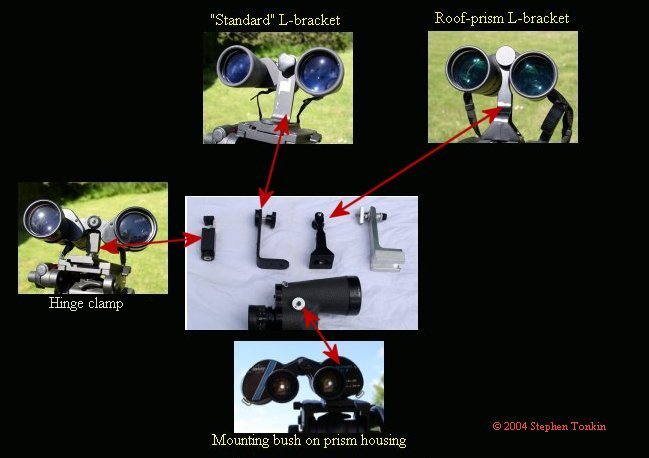
Central Image
Top Row, L to R: Hinge clamp, Standard L-bracket, Roof-prism L-bracket, Universal Astronomics custom L-bracket
Bottom: ¼" mounting bush on prism housing
Most people start out with binoculars similar in size to a 10x50 and consider ways of mounting these on a photo tripod, usually by some sort of L-bracket, unless the binocular has a built-in mounting bush:

Central
Image
Top Row, L to R: Hinge clamp, Standard L-bracket, Roof-prism
L-bracket, Universal Astronomics custom L-bracket
Bottom: ¼"
mounting bush on prism housing
Hinge clamp: As the name suggests, it clamps onto the central hinge
of porro-prism binoculars. May be unsuitable if the binocular has a wide
focusing "band" as opposed to a narrow focusing wheel.
Standard
L-bracket: Screws into the ¼" mounting bush at the distal end of
the central hinge, if the binocular is equipped with one.
Roof-prism
L-bracket: Similar to above, but with recesses for the objective tubes of
roof-prism binocualrs (which are closer together than in porro-prism binocs).
Universal
Astronomics custom L-bracket: Similar to above, but is a proprietary
bracket that fits the Universal Astronomics mounts.
¼"mounting
bush on prism housing: Rarely seen nowadays. Care needs to be taken that the
tripod head allows the binocular to be mounted in such a manner that the
observer's nose does not foul the tripod head! Offers no facility for tilting
the binocular side-to side.
The tripod and head should be chosen with care. As the binocular is pointed
at higher altitudes, the height of the eyepieces decreases. Simultaneously, the
height of your eyes increases as your head is tilted back. Some form of height
adjustment is therefore necessary. This usually takes the form of a raisable
centre-post on the tripod.
The tripod must be sturdy enough so as not
to permit excessive vibration, and high enough to enable the observation of
high-altitude objects from a standing position (photo tripods and heads vary
from infuriating to impossible to use from a seated position for high altitude
targets).
Heads for photographic tripods often do not, when used as
intended, permit altitudes in excess of about 60°: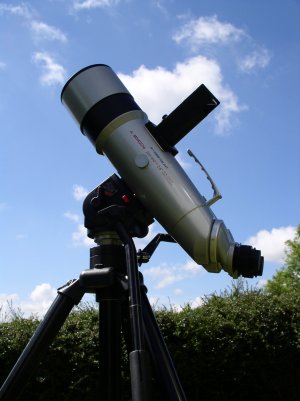
Whilst this may be
as high as you can comfortably observe with "straight through"
binoculars, those with 45° eyepieces can comfortably observe to the zenith.
Photo- and video- heads are usually designed to permit the camera to point
straight down, so the trick is to reverse the head and put the binoculars on the
"wrong" way: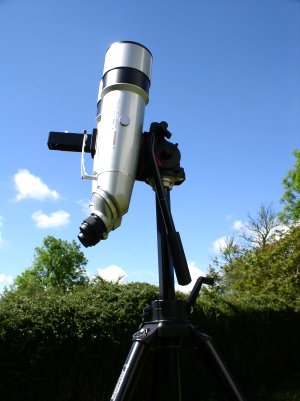
Any handle on the
head will probably need to be reversed, and may therefore get in the way of
tension controls, clamp levers, etc.
A consideration with large, heavy
binoculars is that the centre of mass of the binoculars is some distance from
the altitude fulcrum of the head so, at altitude, there is a considerable
turning moment on the head. Any altitude tension control may need to be set at or near maximum. This, combined with the cantilevered weight of the binocular, can make the the set-up awkward to use.
Parallelogram mounts (P-mounts) offer a great deal of versatility. They are
often cited as advantageous for star-parties or other group observations,
because they permit the height of the eyepieces to be changed without changing
the target object, but the same is true (albeit to a lesser extent) of
centre-post tripods. Basic incarnations of P-mounts may require that the binocular is pointed back over the tripod, but there are sophisticated designs that are much more flexible; the epitome of these is the Universal Astronomics
deluxe mounting head: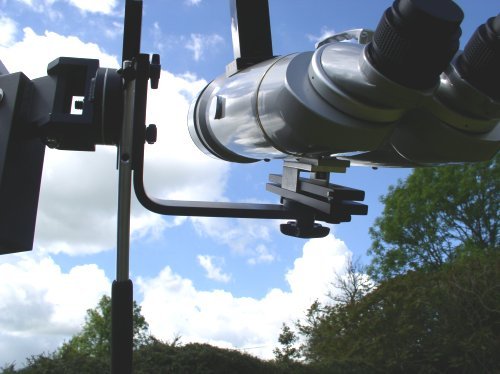
This permits the
binocular to be adjusted so that its centre of mass is exactly aligned with the
altitude fulcrum, so that the binocular does not exert a turning moment on the
fulcrum. The consequence of this, together with the counterweighting, is that
the the binocular feels almost as though it is floating in the air.
Additionally, the additional azimuth fulcrum permits the binocular to be pointed
at a very large proportion of the sky (about a third of it) without any
significant change of observing position. This is obviously a consideration if
you prefer to observe sitting down:
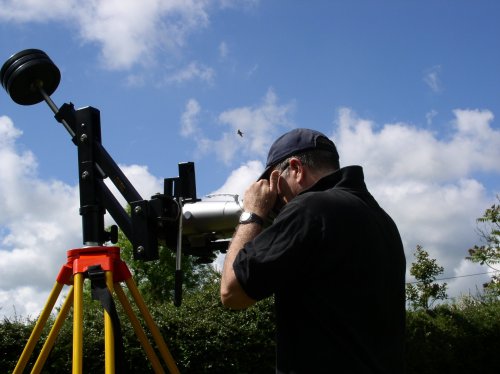 |
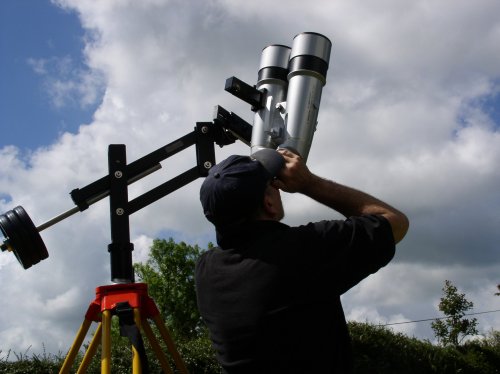 | |
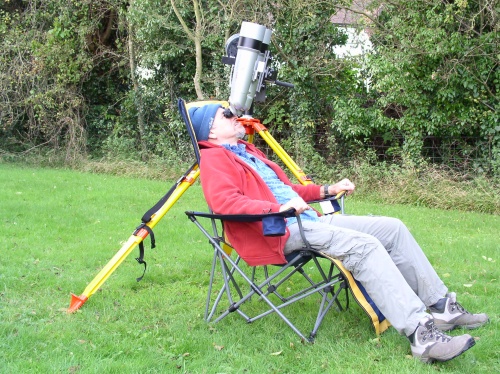 |
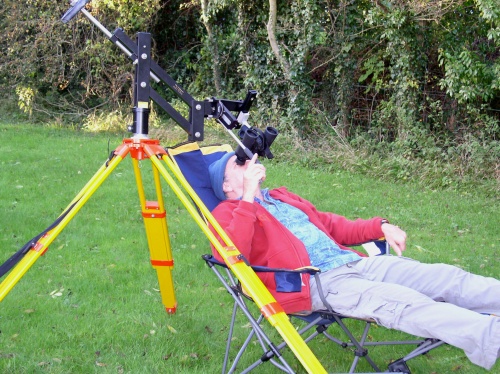 |
The mount shown above is the Universal
Astronomics T-mount, a short parallelogram. Longer parallelograms can permit
reclining, seated, and standing observation from the same tripod height. The
consequence is a much longer turning moment on the tripod and support, resulting
in vibrations taking longer to damp.
P-mounts are amenable to
home-construction if you have woodworking skills. See links below.
CloudyNights Reviews
of Binocular Mounts
Comet Couch
Florian's Binocular Viewing
Accessories (includes a home-made mirror mount)
Craig
Simmons' Binocular Chair
Parallelogram Binocular Mount
(good, simple P-mount with full construction plans)
Scott's Binocular Mount
Page (excellent, versatile home-made P-mount)
Sky Window (commercially made
mirror mount)
Star Chair (the
ultimate observing chair)
